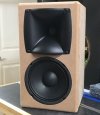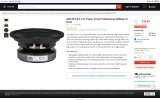computer-audiophile
Major Contributor
Agreed, that's exactly how I see it. I just didn't understand the close relationship of the design with Genelec, who produce particularly sophisticated professional loudspeakers with a development effort of many man-years.My reason for sharing is to say that a person should focus on the aspect of speaker design that they are interested in.
BTW: As a classical music listener, I don't attach much importance to sub-bass. I'm more in tune with Paul W Klipsch, who once said: 'the midrange is where we live'.




